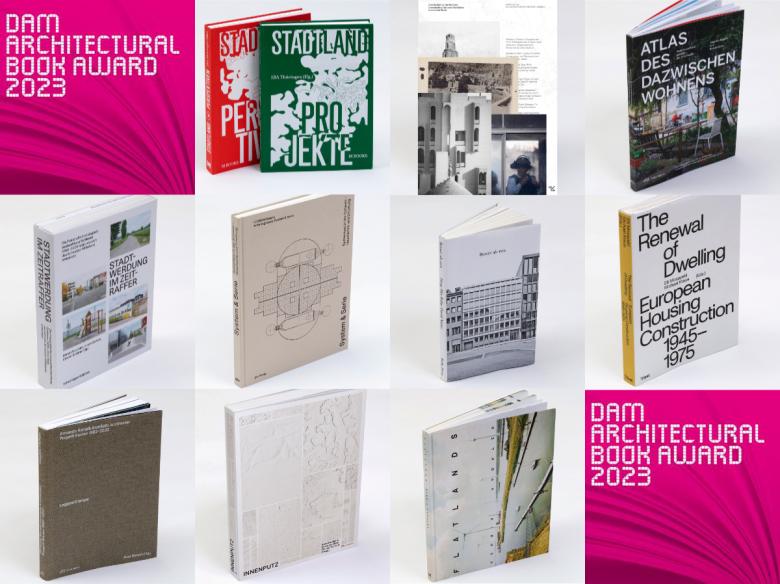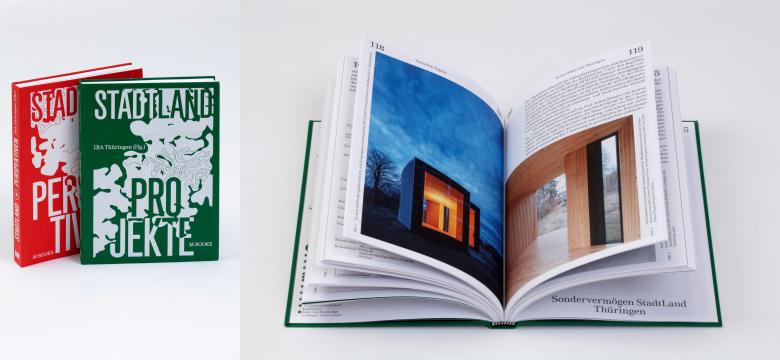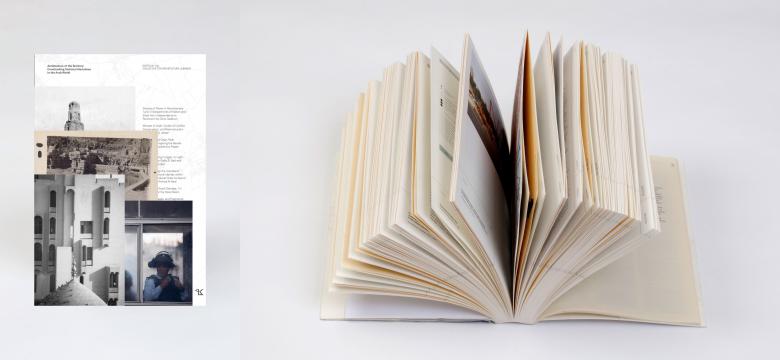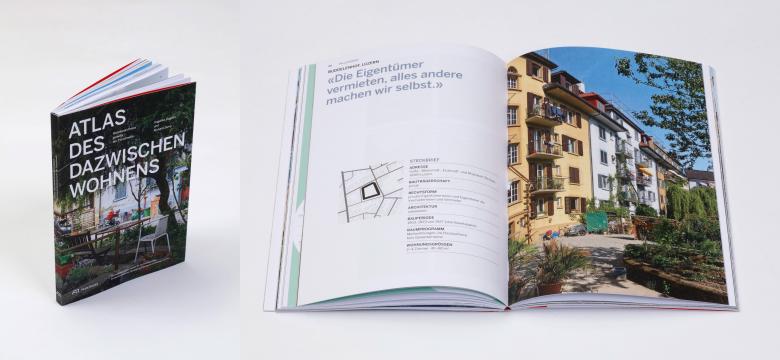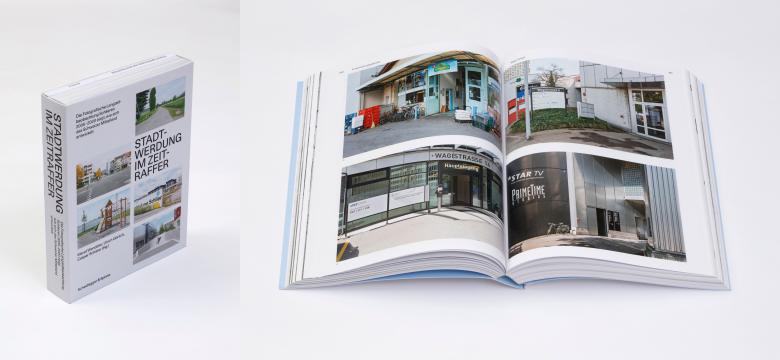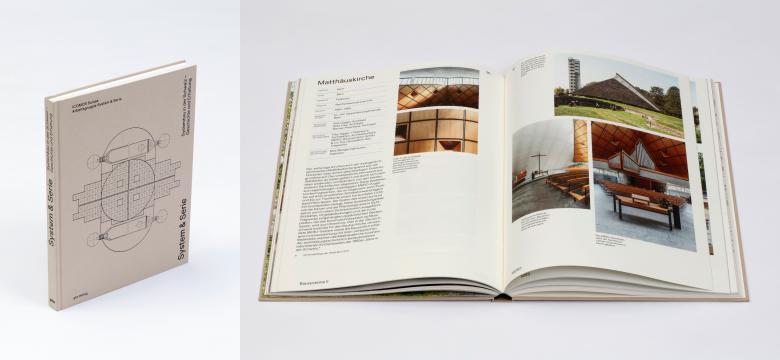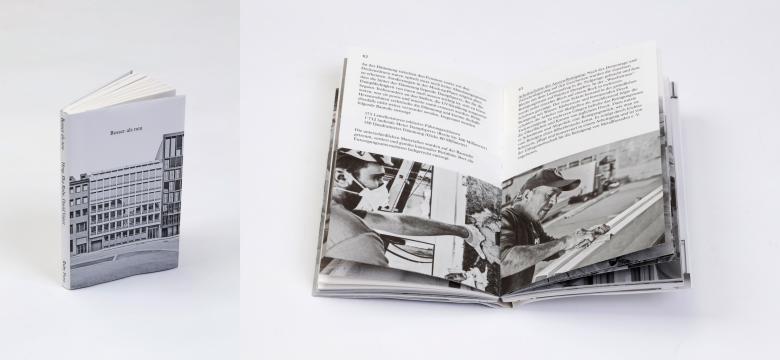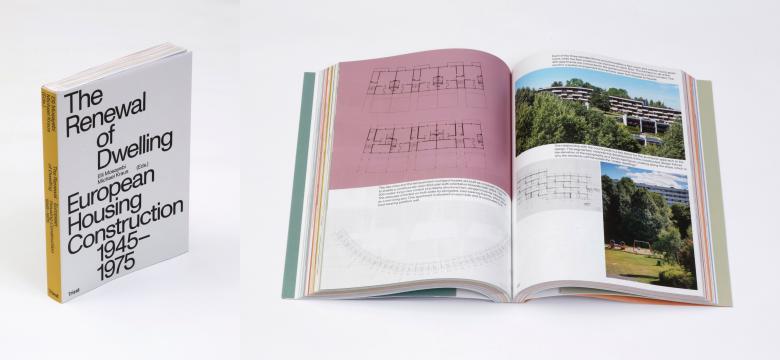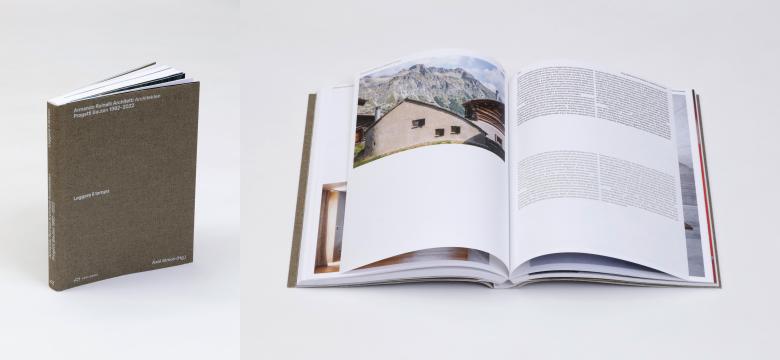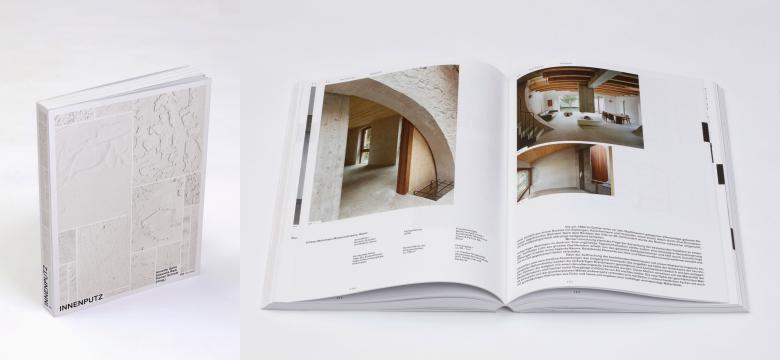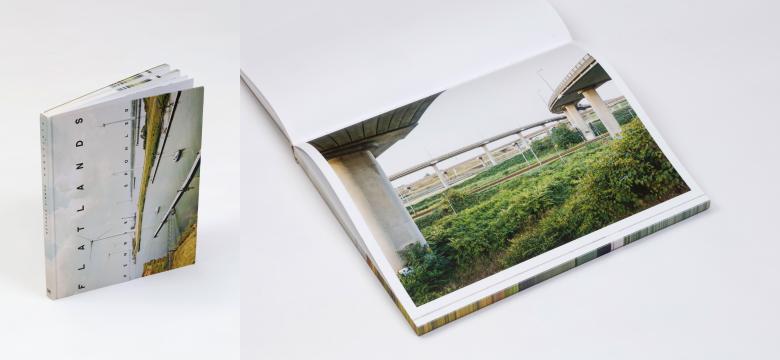19. October 2023
Image: World-Architects; cover photographs courtesy of DAM
The Deutsches Architekturmuseum (DAM) and Frankfurt Book Fair have announced the winners of 2023 DAM Architectural Book Award, selecting the ten best architecture books from 245 submissions from 102 publishers.
Taking a quick glance at the ten winners of the 2023 DAM Architectural Book Awards — featured below, in order of the announcement from DAM — one would be forgiven for thinking it is a regional award rather than, as it is billed, an international award. Take the facts that nine out of the ten winners are from publishers in Germany or Switzerland (six from Zurich alone!) and that exactly half of the winners are solely German-language books. By comparison, last year's list of winners had seven out of ten books published in Germany or Switzerland, and if we go back as far as 2014 (the award was created in 2009), six of the ten winners were from publishers in the two countries. So while the DAM Architectural Book Award has always had a regional bias, the trend is toward total two-country domination, toward no books from outside Germany and Switzerland garnering any awards.
What could be the reasons for so many winners in an international book award going to a narrow segment of architectural publishing? To speculate, the most obvious one is that perhaps the best architecture books are being made in Germany and Switzerland; given the attention to detail in the architecture books made in Zürich and other locales — subject matter and contents, page design and typography, photography and illustrations, paper selection and bindings, etc. — it's not hard to come to this conclusion. But a regional bias could also arise from which books are submitted; if publishers in Japan, the US, Australia, and other countries actually sent their books for consideration or opted not to, perhaps due to their titles in previous years not garnering awards on a consistent basis. And then there is the jury, which this year was made up of architect Kathrin Siebert, designer Ellen Schulte, photographer Marcus Bredt, architect Danny Lettkemann, editor Friederike Meyer, bookseller Reinhard Neumann, and Andrea Jürges and Annette Becker from DAM — all from Switzerland and Germany, best I can tell.
These speculations come from the list itself, but also from the fact I don't have any of these books — or the ten shortlisted books listed at the bottom — in my possession. And that gets at perhaps the most important quality of books: they are physical constructions that people touch and interact with, not just read with their eyes, like pixels on a screen. So, while I bemoan the narrow geography of the winners, seeing and touching them might easily persuade me of their worth, of their merits, some of which are capably described by the jurors below.
StadtLand Perspektiven: Für eine neue Raumkultur (in combination with) StadtLand Projekte: Für eine neue Raumpraxis / M Books (Photos courtesy of DAM)
StadtLand Perspektiven: Für eine neue Raumkultur (in combination with) StadtLand Projekte: Für eine neue Raumpraxis
Publisher: M Books, Weimar (DE)
Authors: Dr. Marta Doehler-Behzadi, Kerstin Faber, Katja Fischer, Tobias Haag, Kim Marie Müller, Ulrike Rothe, Dr. Bertram Schiffers, Elisa Wrobel
Editor: Internationale Bauausstellung (IBA) Thüringen
Design: Lamm and Kirch with Caspar Reuss
Language: German
Jury statement, excerpt (Ellen Schulte): “The two volumes, published by M Books, focus in depth on the topics of ‘Projects – for a new spatial practice’ and ‘Perspectives – for a new spatial culture.’ The respective cover design in radiant red [and] dark green, in combination with the slight embossing and white screen-printing, create a real eye-catcher, even from a distance. The publications form an invaluable archive and a creative expression of how architecture and design can play a decisive role in shaping a sustainable future geared to the common good. Just as the IBA Thuringia projects are pilot projects that encourage you to copy them, so the book design can definitely be considered a model to follow.”
Architecture of the Territory – Constructing National Narratives in the Arab World / Kaph Books (Photos courtesy of DAM)
Architecture of the Territory – Constructing National Narratives in the Arab World
Publisher: Kaph Books, Beirut (LB)
Editor: Collective for Architecture Lebanon (Edouard Souhaid, Shereen Doummar, Elias Tamer)
Contributors: FAhmad AlAqra, Ali Karimi, Asaiel Al Saeed, Aseel Alyacoub, Balsam Madi, Ben Tosland, Carine Assaf, Christine Mady, Dena Qaddumi, Eleftheria Exarchou, Faysal Tabbarah, Francois Nour, Galila Elkadi, Hamed Bukhamseen, Hanadi Samhan, Hareth Ramzi, Hicham Bou
Designer: Nathalie El Mir
Language: English
Jury statement, excerpt (Reinhard Neumann): “An easy-to-grasp structure on the cover and the pages inside convey the great variety of topics. A total of 28 essays by different authors describe current Arab societies and nations. Each chapter is introduced by a cover sheet marked in color (yellow). Key facts and figures on the country and more extensively on the author of the subsequent essay give a clear impression of their expertise. This applies to both their practical work and their scholarly credentials, which rest on activities at international universities. The texts are themselves clearly structured and the content in each is visualized by graphics, images, and maps. Emphasis is placed on considerations on architecture, urban planning, agriculture, climate trends and impacts, and historical background. The result is a weighty tome that offers a cross-section on the reality of Arab life and thus pointers to the future design of these regions.”
Atlas des Dazwischenwohnens: Wohnbedürfnisse jenseits der Türschwelle / Park Books (Photos courtesy of DAM)
Atlas des Dazwischenwohnens: Wohnbedürfnisse jenseits der Türschwelle
Publisher: Park Books, Zürich (CH)
Editors: Hochschule Luzern, Institut für Architektur, Kompetenzzentrum Typologie und Planung
Authors: Angelika Juppien, Richard Zemp
Designer: Elke Schultz
Language: German
Jury statement, excerpt (Kathrin Siebert): “What kind of living can there be in semi-public and public zones? How do the inhabitants appropriate it for themselves? In order to answer these questions, [the Atlas des Dazwischenwohnens, of the living spaces in-between] first outlines different housing needs and summarizes them in both impactful and charming terms, such as Adventure, Change of Scene, and Magic. It then goes on to specify places of ‘living in-between’ and has the inhabitants themselves document these. Finally, a concrete aid for orientation is developed in order to enable readers to find the so-called ‘spaces in-between’ themselves, describe them, and analyze them. In the second section of the easy-to- use book, six case studies are presented on the basis of the methods developed in the earlier part. It’s exciting to read how a variety of players are involved and express their opinions.”
Stadtwerdung im Zeitraffer: Die Fotografische Langzeitbeobachtung Schlieren 2005 – 2020 zeigt, wie sich das Schweizer Mittelland entwickelt / Scheidegger & Spiess (Photos courtesy of DAM)
Stadtwerdung im Zeitraffer: Die Fotografische Langzeitbeobachtung Schlieren 2005 – 2020 zeigt, wie sich das Schweizer Mittelland entwickelt (Urban Change Over Time: The Photographic Observation of Schlieren 2005–2020 Reveals How Switzerland Is Changing)
Publisher: Scheidegger & Spiess, Zürich (CH)
Editor: Meret Wandeler, Ulrich Görlich, Caspar Schärer
Designer: Marco Walser - Elektrosmog
Language: German/English
Jury statement, excerpt (Friederike Meyer): “The content delivers on what the title and cover promise. The book’s structure derives from the topic, explores many different aspects of the theme, and yet is very careful not to waste the reader’s time. All of these criteria for a good architecture book are fulfilled by the twin-volume ‘Stadtwerdung im Zeitraffer,’ despite it running to no less than 630 pages. It takes us on a journey to the Swiss Plateau, to Schlieren, to a community in the belt of settlements agglomerated around Zurich, to a place joined in the course of 15 years by no less than 7,000 new inhabitants, where in some places there are now dense buildings and in others as little as nothing has changed. The book wins the prize not least also for its great vision and the endurance necessary to create such long- standing photographic coverage of the process of growing into a town.”
System und Serie: Systembau in der Schweiz – Geschichte und Erhaltung / gta Verlag ETH Zürich (Photos courtesy of DAM)
System & Serie: Systembau in der Schweiz – Geschichte und Erhaltung
Publisher: gta Verlag, Zürich (CH)
Editor: ICOMOS Suisse Arbeitsgruppe System & Serie
Designer: Nadine Rinderer
Language: German
Jury statement, excerpt (Andrea Jürges with Confiyet Aydin): “The book on the history and preservation of Swiss integrated system construction forms not only a crucial part of architecture literature in 2023 but is also a key addition rounding out existing documentation in architecture history. The work offers a deeper look into the world of integrated system construction by taking comprehensive stock of the status of the subject and an interdisciplinary approach that covers not only architecture but also building structures and building physics. It skillfully combines research in architectural history with architectural practice. The multidisciplinary approach, the impressive images and graphics, and its great impact for heritage protection and future construction work make it an appealing read for architects, scholars, and everyone else interested in the development and preservation of our built environment. It deserves a fixed place on people’s bookshelves.”
Besser als neu: Wie man eine Bürofassade emissionsarm und zirkular saniert / Ruby Press (Photos courtesy of DAM)
Besser als neu: Wie man eine Bürofassade emissionsarm und zirkular saniert
Publisher: Ruby Press, Berlin (DE)
Editors: Ilka Ruby, David Vaner
Authors: Charlotte Bofinger, Andreas Ruby, David Vaner
Designer: Something Fantastic
Language: German
Jury statement, excerpt (Kathrin Siebert): “Besser als neu – better than new – is a publication that is dedicated to the highly topical issue of resource efficiency in construction. Preserving our built environment and reusing building components and materials has a key role to play here. Taking the example of modernizing the façade of an office building in Basel, Switzerland, the book shows how to create a low-emission and circular system. The strikingly small-format volume delivers on what the sub-title promises. Not only is the important and highly complex topic rendered accessible for a broad readership by means of a real-life example, but it is also presented very vividly and in an appealing manner. Especially worthy of note are not just the intelligently positioned essays but also the photo series that document the construction process. In these images, the focus is not only on architectural details, but also on the people who realize the project as a whole.”
The Renewal of Dwelling: European Housing Construction 1945 – 1975 / Triest Verlag (Photos courtesy of DAM)
The Renewal of Dwelling: European Housing Construction 1945–1975
Publisher: Triest Verlag, Zürich (CH)
Editors: Elli Mosayebi and Michael Kraus
Authors: Jasper Cepl mit Sam Jacoby, Valerio Massaro, Irina Davidovici, Philippe Dufieux, Nuno Grande und Anne-Kristine Kronborg
Designer: Büro 146 (Maike Hamacher, Madeleine Stahel, Valentin Hindermann mit Marcel Schirmer)
Language: English
Jury statement, excerpt (Danny Lettkemann): “The lion’s share of apartment tenement blocks in Europe were erected between 1945 and 1975; in the first three decades after World War II there was an immense demand for new apartments. To this day, millions of people have their homes in the countless housing complexes built back then. The public sector played a major role in helping master the housing shortage. This book presents about 50 projects, with the focus on the cities of Cologne, Lyon, Oslo, Porto, and Zagreb. Moreover, the cities of Leeds, Liverpool, Manchester, and Sheffield are also included. The book shows clearly how it was possible given the challenges to nevertheless achieve the fundamental renewal of the housing stock and realize it architecturally. Especially noteworthy is the typographical design, which creates a clear structure and likewise ensures the great variety of pictorial material comes into its own.”
Armando Ruinelli Architekten: Bauten 1982 – 2022. Leggere il tempo / Park Books (Photos courtesy of DAM)
Armando Ruinelli Architekten: Bauten 1982–2022. Leggere il tempo
Publisher: Park Books, Zürich (CH)
Editor: Axel Simon
Photographer: Katalin Deér
Designer: Tiziana Artemisio, Milana Herendi - Herendi Artemisio
Language: German/Italian
Jury statement, excerpt (Danny Lettkemann): “The monograph on the oeuvre of architect Armando Ruinelli is persuasively simple and poignant. The entire book’s layout is very clear in structure. The content harmonizes superbly with the design to create a sensory experience. This book highlights the sheer breadth of Ruinelli’s development as an architect. Starting with his first buildings in his native village in the 1980s through modernization projects and new builds that preserve the local traditions and at the same time accord with contemporary notions of housing, through to his latest undertakings in which his architectural expression achieves a certain autonomy… Armando Ruinelli is undoubtedly a gift to his local community and the entire region and serves as a fine role model for how a village can develop through harmonious design for all the changed requirements and usages. In the course of the book it becomes abundantly clear what a favorable influence an architect like him can have before people start building in a haphazard way in a village. It is highly enjoyable to immerse oneself in the book and thus in Ruinelli’s thought and works.”
Innenputz / Park Books (Photos courtesy of DAM)
Innenputz
Publisher: Park Books, Zürich (CH)
Editors: Annette Spiro, Elizabeta Radi, Florian Schrott
Photographer: Pavel Horák
Designer: Esther Rieser
Language: German
Jury statement, excerpt (Annette Becker): “The most beautiful thing about the book is its cover. When you first take it into your hands you are immediately tempted to touch the different types of rendering. The bulky manual stands out for its exceptionally pleasant haptics. On leafing through it, you will come across large illustrations and detailed images, plans and graphic elements, not to mention recurrent illustrations of the specific material. All of this is interwoven with the different blocks of text to create a lively read. Inside the book, the focus is first and foremost on visualizing the immense potential of the material. All of this is vividly described by showing a larger number of applications in historical and in contemporary buildings. They all prompt the reader to consider the incredible opportunities rendering offers.”
Henrik Spohler – Flatlands / Hartmann Books (Photos courtesy of DAM)
Henrik Spohler – Flatlands
Publisher: Hartmann Books, Stuttgart (DE)
Authors: Henrik Spohler, Gerbrand Bakker
Photographer: Henrik Spohler
Designer: Florian Pfeffer, one/one studio
Language: German/English/Dutch
Jury statement, excerpt (Marcus Bredt): “The selection of pure photobooks was not great this year, and yet if it had only been about photobooks, Flatlands would have remained very high up on my list. The presentation and aesthetics immediately catch the eye, the print extends from the cover across the edges, the classic thread stitching makes leafing through it and viewing images all the more pleasant and the beautiful printing on matt paper ensures the overall result is a very fine book. The topic is the Netherlands. Henrik Spohler takes us along to a photographic viewing of the countryside. He has us discover how people have artificially appropriated the countryside in a country which played so strong a role in the development of the landscape painting as a genre back in the 17th century. With great curiosity he explores the flat lands outside the densely populated conurbations and shows us countryside packed full of things, crisscrossed by a complex network of roads, canals, rail tracks, and locks, in which every square meter is being used by people. It is not the first book by Henrik Spohler, and I’m already looking forward to the next one.”
Shortlist DAM Architectural Book Award 2023:
- Convivial Ground: Stories from collaborative spatial practices / JOVIS Verlag
- KANAL: THINKING / #1 / Atelier KANAL
- Das Kollektiv: Formen und Vorstellungen gemeinschaftlicher Architekturproduktion in der DDR / Urbanophil
- Feine Fassaden – Tektonik Schweizer Stadthäuser / Quart Verlag
- Blind Date with the Future / Jap Sam Books
- Solar Futures: How to design a post-fossil world with the sun / Jap Sam Books
- Social Loft – Auf der Suche nach neuen Wohnformen | En quête de nouvelles formes d‘habitat / Triest Verlag
- Kosmos Hinterhof – Einblicke und Perspektiven / Christoph Merian Verlag
- The last Grand Tour – Contemporary phenomena and strategies of living in Italy / Park Books
- Life in the New / Kerber Verlag
